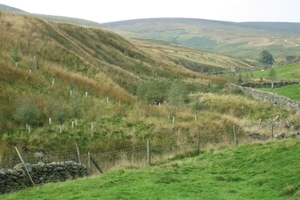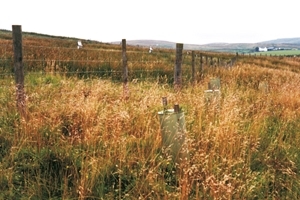Size of woods
Depending on a woodland’s size, its use by black grouse may vary. Large woodlands could be used for breeding and small woodlands predominantly for winter feeding and avoiding predators. Planting and restructuring should therefore consider these different objectives. To be compatible with local landscape and to avoid encroachment on other habitats of conservation importance, most proposed woodlands in the region are likely to be small (under 5ha and often appreciably smaller) and frequently in sheltered gills. Such woods are best at providing winter-feeding and these notes reflect that. Increasingly large woodlands can accommodate nesting and chick rearing. As a general guide, woods over 3ha could incorporate features to encourage breeding by black grouse (wide spacing and open ground – see below). This becomes more important with increasing size. Woodland shape is also relevant, with long thin woods more akin to those described here as ‘small’ regardless of overall size.
Species to plant
Suitable trees and shrubs are (the proportions recommended vary between sites, but typical ranges are shown):
- Birch (Betula pubescens) 15-30%
- Rowan (Sorbus aucuparia) 15-20%
- Hawthorn (Cratagus monogyna) 40-50%
- Willows (Salix cinerea, S caprea, and/or S aurita) 15-30%
- Alder (Alnus glutinosa) 15-20%
- Juniper (Juniperus comunis) 5-15%
 A small proportion of other species (up to 5%) especially Scots pine (Pinus sylvestris) and larch (Larix decidua) is acceptable. Where there are red squirrels, to discourage greys avoid species bearing large seeds (e.g. oak, hazel, sycamore and beech). In some instances, using fast-growing conifers (e.g. spruce) may be appropriate as a nurse crop (and to provide cover in the shorter term) as long as they are removed once the other species are established (after five to eight years). These species can also be used on edges of larger woods (e.g. commercial plantations, shelterbelts or other larger native-type woodland planting). For new native woodlands the principles and guidelines given in Forestry Commission Bulletin 112 should be followed. Alder trees should be of north country stock and junipers must be of local source and planted in naturally-occurring sites and patterns.
A small proportion of other species (up to 5%) especially Scots pine (Pinus sylvestris) and larch (Larix decidua) is acceptable. Where there are red squirrels, to discourage greys avoid species bearing large seeds (e.g. oak, hazel, sycamore and beech). In some instances, using fast-growing conifers (e.g. spruce) may be appropriate as a nurse crop (and to provide cover in the shorter term) as long as they are removed once the other species are established (after five to eight years). These species can also be used on edges of larger woods (e.g. commercial plantations, shelterbelts or other larger native-type woodland planting). For new native woodlands the principles and guidelines given in Forestry Commission Bulletin 112 should be followed. Alder trees should be of north country stock and junipers must be of local source and planted in naturally-occurring sites and patterns.
Planting density
This should be in the order of 400-800 stems per hectare (preferably towards the lower end of that range). The higher planting densities would be more appropriate for smaller woods (less than 2ha). Uneven planting that creates some dense clumps and also sparse areas can be incorporated in larger woods.
Open ground
The extent of open ground that remains unplanted will partly depend on woodland size. Woods over 3ha should include at least 40% open space. Between 1 and 3ha, this proportion should be between 20-40%. A reduced proportion may be acceptable for the smallest of woods. Wet flushes, typified by rushes and tussock grasses, should be included along with dwarf shrubs as areas to be protected within open ground. The area of open ground should be excluded from the proposed planting density.
Edge design
Uneven edges should be encouraged, maximising the woodland edge available where scrub-developing species should also be concentrated. Fencing a larger area than the actual area of woodland can create an ungrazed ‘strip’, which may add diversity to the ground vegetation. For many small woods (e.g. under 5ha) in the region, much of the open ground component will be incorporated in the edge design.
Adding edge
Plant black grouse habitat alongside the edges and boundaries of existing woods to form aprons of suitable habitat between plantations and moorland.
Siting of woods
Woods in gills or on slopes, rather than on open ground, give advantages of (a) providing a food source which is often needed during hard weather in the most sheltered, and most appropriate areas, (b) not creating elevated perches overlooking open ground as vantage points for avian predators (e.g. crows), and (c) not affecting an otherwise open landscape. Some isolated and very small scale planting on open ground may have an advantage of attracting corvids to be culled, but this will only be worth considering where effective predator control can be guaranteed.
Fencing
 Collisions with fences can be a significant cause of mortality for black grouse. Stock and possibly rabbit-proof fencing is often essential to establish a proposed new wood. However, fences could be positioned to reduce the risks of black grouse flying into them. Those which pose the greatest threats are likely to be along skylines and convex breaks of slope, so sympathetic positioning should minimise risk. For example, fences which run along the upper edges of gills should be avoided and should be placed some way down the slope or back from the slope, avoiding the skyline. All new fences should include visual marking deterrents. The ground vegetation within a planted area can provide suitable nesting and chick-rearing cover (most relevant for the open structured woods). Rabbit netting will prevent chicks roaming into or out of the wood. We therefore recommend that wide mesh stock fencing is used. Where possible trees should be planted in tubes or within spiral guards to prevent rabbit and hare damage.
Collisions with fences can be a significant cause of mortality for black grouse. Stock and possibly rabbit-proof fencing is often essential to establish a proposed new wood. However, fences could be positioned to reduce the risks of black grouse flying into them. Those which pose the greatest threats are likely to be along skylines and convex breaks of slope, so sympathetic positioning should minimise risk. For example, fences which run along the upper edges of gills should be avoided and should be placed some way down the slope or back from the slope, avoiding the skyline. All new fences should include visual marking deterrents. The ground vegetation within a planted area can provide suitable nesting and chick-rearing cover (most relevant for the open structured woods). Rabbit netting will prevent chicks roaming into or out of the wood. We therefore recommend that wide mesh stock fencing is used. Where possible trees should be planted in tubes or within spiral guards to prevent rabbit and hare damage.